
Winslow Homer Giclée Fine Art Prints 1 of 4
1836-1910
American Realist Painter
The trajectory of Winslow Homer's artistic life reveals a particularly American form of creative independence, one that emerged from commercial necessity yet evolved into something far more substantial. Born in Boston on February 24, 1836, Homer entered a world where American art was still finding its distinctive voice, caught between European influences and the raw vitality of a nation discovering itself. His path from commercial lithographer to one of the most significant painters of nineteenth-century America suggests not merely talent, but a remarkable capacity for self-determination that would characterize both his work and his increasingly solitary existence.
The formative influence of his mother, Henrietta Maria Benson Homer, an accomplished amateur watercolorist, cannot be understated. She provided not only technical instruction but transmitted a sensibility - a way of seeing that privileged direct observation over academic convention. This maternal legacy, combined with what Homer himself described as his liberation from the "treadmill experience" of his lithographic apprenticeship under J. H. Bufford, established the foundation for an artistic philosophy rooted in independence. When he declared, "From the time I took my nose off that lithographic stone, I have had no master, and never shall have any," he articulated not merely personal preference but an aesthetic manifesto.
Homer's twenty-year career as an illustrator, primarily for Harper's Weekly, deserves reconsideration beyond its role as mere preparation for his painting career. These years honed his ability to distill narrative essence into visual form, to capture the telling moment with economy and precision. His Civil War sketches, created under dangerous conditions at the front lines, demonstrate how illustration served as a crucible for developing his distinctive approach to composition and his unflinching directness of vision. The transition from works like Sharpshooter on Picket Duty to Prisoners from the Front reveals an artist learning to infuse documentary observation with psychological complexity.
The Paris sojourn of 1867 presents an intriguing paradox. At a moment when French painting was experiencing revolutionary upheaval through Impressionism, Homer aligned himself with the more conservative Barbizon tradition, finding kinship with Millet's peasant subjects rather than Manet's modernist provocations. This choice speaks to Homer's essential pragmatism - he absorbed what served his vision while maintaining his commitment to American subjects and sensibilities. His development of plein-air techniques preceded any direct French influence, suggesting parallel evolution rather than derivative adoption.
The 1870s marked a period of thematic exploration that, while sometimes dismissed as sentimental, actually reveals Homer's sophisticated understanding of American social dynamics. Paintings like Snap the Whip and The Morning Bell capture not merely nostalgic scenes of rural life but document a society in transition, where traditional patterns persisted even as industrialization encroached. His depictions of African American life, particularly in works like A Visit from the Old Mistress, demonstrate remarkable restraint and dignity, avoiding both caricature and false nobility to present complex human interactions during Reconstruction.
The transformation that occurred during Homer's residence in Cullercoats, Northumberland, from 1881 to 1882, represents perhaps the most crucial turning point in his artistic development. The encounter with the harsh North Sea environment and the stoic fishing communities catalyzed a fundamental shift in both palette and philosophy. The watercolors from this period abandon the bright clarity of his American work for a more somber, monumental approach. The fisherfolk became not picturesque subjects but embodiments of human endurance against elemental forces.
Homer's retreat to Prouts Neck, Maine, in 1883 appears less as withdrawal than as strategic positioning. Living seventy-five feet from the ocean in a converted carriage house, he placed himself at the intersection of civilization and wilderness, observation post for his great sea paintings. Works like The Fog Warning and Eight Bells transcend marine painting to become meditations on human vulnerability and competence in the face of natural immensity. These are not romantic celebrations of the sea but clear-eyed assessments of its power and indifference.
The Caribbean and Florida watercolors of the mid-1880s reveal another facet of Homer's complexity. Far from being mere respites from Maine winters, these southern works explore light and color with renewed vigor while maintaining his characteristic restraint. The Gulf Stream, with its isolated Black sailor surrounded by sharks, synthesizes his marine interests with subtle social commentary, creating an image that operates simultaneously as adventure narrative, natural history study, and existential allegory.
Homer's late work achieves a remarkable synthesis of observation and abstraction. Paintings like Northeaster reduce the sea to essential forces - wave, rock, spray - yet maintain their basis in specific observation. His advice to "Leave rocks for your old age - they're easy" contains typical Homer irony, as these late seascapes represent some of his most technically and conceptually challenging work. The apparent simplicity masks profound understanding of natural dynamics and painterly structure.
What emerges from examining Homer's biographical arc is an artist who achieved a rare balance between commercial viability and artistic integrity. His financial struggles through much of his career never prompted him to compromise his vision or court popular taste. The reclusive tendency of his later years seems less misanthropy than necessary focus, a recognition that his work required undivided attention to nature's rhythms rather than society's demands.
Homer's legacy transcends influence on subsequent painters like the Wyeth dynasty. He established a model for American artists that valued direct experience over theoretical knowledge, subject matter integrity over stylistic innovation, and patient observation over facile virtuosity. His insistence that artists should "stutter in a language of their own" rather than absorb influences from other paintings articulates a philosophy of creative authenticity that remains compelling. In Homer, American art found not its first independent voice, but perhaps its most uncompromising one.
The formative influence of his mother, Henrietta Maria Benson Homer, an accomplished amateur watercolorist, cannot be understated. She provided not only technical instruction but transmitted a sensibility - a way of seeing that privileged direct observation over academic convention. This maternal legacy, combined with what Homer himself described as his liberation from the "treadmill experience" of his lithographic apprenticeship under J. H. Bufford, established the foundation for an artistic philosophy rooted in independence. When he declared, "From the time I took my nose off that lithographic stone, I have had no master, and never shall have any," he articulated not merely personal preference but an aesthetic manifesto.
Homer's twenty-year career as an illustrator, primarily for Harper's Weekly, deserves reconsideration beyond its role as mere preparation for his painting career. These years honed his ability to distill narrative essence into visual form, to capture the telling moment with economy and precision. His Civil War sketches, created under dangerous conditions at the front lines, demonstrate how illustration served as a crucible for developing his distinctive approach to composition and his unflinching directness of vision. The transition from works like Sharpshooter on Picket Duty to Prisoners from the Front reveals an artist learning to infuse documentary observation with psychological complexity.
The Paris sojourn of 1867 presents an intriguing paradox. At a moment when French painting was experiencing revolutionary upheaval through Impressionism, Homer aligned himself with the more conservative Barbizon tradition, finding kinship with Millet's peasant subjects rather than Manet's modernist provocations. This choice speaks to Homer's essential pragmatism - he absorbed what served his vision while maintaining his commitment to American subjects and sensibilities. His development of plein-air techniques preceded any direct French influence, suggesting parallel evolution rather than derivative adoption.
The 1870s marked a period of thematic exploration that, while sometimes dismissed as sentimental, actually reveals Homer's sophisticated understanding of American social dynamics. Paintings like Snap the Whip and The Morning Bell capture not merely nostalgic scenes of rural life but document a society in transition, where traditional patterns persisted even as industrialization encroached. His depictions of African American life, particularly in works like A Visit from the Old Mistress, demonstrate remarkable restraint and dignity, avoiding both caricature and false nobility to present complex human interactions during Reconstruction.
The transformation that occurred during Homer's residence in Cullercoats, Northumberland, from 1881 to 1882, represents perhaps the most crucial turning point in his artistic development. The encounter with the harsh North Sea environment and the stoic fishing communities catalyzed a fundamental shift in both palette and philosophy. The watercolors from this period abandon the bright clarity of his American work for a more somber, monumental approach. The fisherfolk became not picturesque subjects but embodiments of human endurance against elemental forces.
Homer's retreat to Prouts Neck, Maine, in 1883 appears less as withdrawal than as strategic positioning. Living seventy-five feet from the ocean in a converted carriage house, he placed himself at the intersection of civilization and wilderness, observation post for his great sea paintings. Works like The Fog Warning and Eight Bells transcend marine painting to become meditations on human vulnerability and competence in the face of natural immensity. These are not romantic celebrations of the sea but clear-eyed assessments of its power and indifference.
The Caribbean and Florida watercolors of the mid-1880s reveal another facet of Homer's complexity. Far from being mere respites from Maine winters, these southern works explore light and color with renewed vigor while maintaining his characteristic restraint. The Gulf Stream, with its isolated Black sailor surrounded by sharks, synthesizes his marine interests with subtle social commentary, creating an image that operates simultaneously as adventure narrative, natural history study, and existential allegory.
Homer's late work achieves a remarkable synthesis of observation and abstraction. Paintings like Northeaster reduce the sea to essential forces - wave, rock, spray - yet maintain their basis in specific observation. His advice to "Leave rocks for your old age - they're easy" contains typical Homer irony, as these late seascapes represent some of his most technically and conceptually challenging work. The apparent simplicity masks profound understanding of natural dynamics and painterly structure.
What emerges from examining Homer's biographical arc is an artist who achieved a rare balance between commercial viability and artistic integrity. His financial struggles through much of his career never prompted him to compromise his vision or court popular taste. The reclusive tendency of his later years seems less misanthropy than necessary focus, a recognition that his work required undivided attention to nature's rhythms rather than society's demands.
Homer's legacy transcends influence on subsequent painters like the Wyeth dynasty. He established a model for American artists that valued direct experience over theoretical knowledge, subject matter integrity over stylistic innovation, and patient observation over facile virtuosity. His insistence that artists should "stutter in a language of their own" rather than absorb influences from other paintings articulates a philosophy of creative authenticity that remains compelling. In Homer, American art found not its first independent voice, but perhaps its most uncompromising one.
86 Winslow Homer Artworks
Page 1 of 4
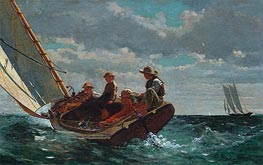
Giclée Canvas Print
$61.68
$61.68
SKU: 15791-HOM
Winslow Homer
Original Size:61.5 x 97 cm
National Gallery of Art, Washington, USA
Winslow Homer
Original Size:61.5 x 97 cm
National Gallery of Art, Washington, USA
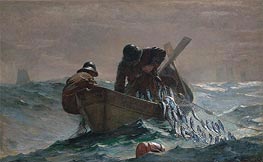
Giclée Canvas Print
$61.68
$61.68
SKU: 8307-HOM
Winslow Homer
Original Size:76.5 x 123 cm
Art Institute of Chicago, Illinois, USA
Winslow Homer
Original Size:76.5 x 123 cm
Art Institute of Chicago, Illinois, USA
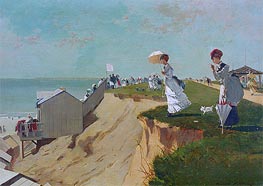
Giclée Canvas Print
$64.12
$64.12
SKU: 15742-HOM
Winslow Homer
Original Size:38 x 54.6 cm
Boston Museum of Fine Arts, Massachusetts, USA
Winslow Homer
Original Size:38 x 54.6 cm
Boston Museum of Fine Arts, Massachusetts, USA
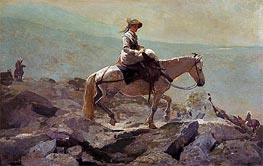
Giclée Canvas Print
$61.68
$61.68
SKU: 15746-HOM
Winslow Homer
Original Size:61 x 96.5 cm
The Clark Art Institute, Massachusetts, USA
Winslow Homer
Original Size:61 x 96.5 cm
The Clark Art Institute, Massachusetts, USA

Giclée Canvas Print
$61.68
$61.68
SKU: 15793-HOM
Winslow Homer
Original Size:97 x 59 cm
National Gallery of Art, Washington, USA
Winslow Homer
Original Size:97 x 59 cm
National Gallery of Art, Washington, USA
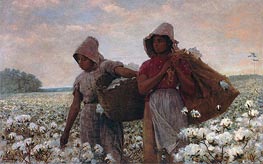
Giclée Canvas Print
$61.68
$61.68
SKU: 5574-HOM
Winslow Homer
Original Size:61 x 96.8 cm
Los Angeles County Museum of Art, California, USA
Winslow Homer
Original Size:61 x 96.8 cm
Los Angeles County Museum of Art, California, USA
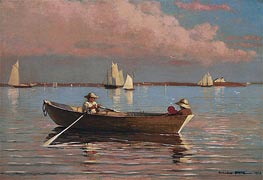
Giclée Canvas Print
$64.08
$64.08
SKU: 15808-HOM
Winslow Homer
Original Size:39.3 x 56.8 cm
Nelson-Atkins Museum of Art, Kansas City, USA
Winslow Homer
Original Size:39.3 x 56.8 cm
Nelson-Atkins Museum of Art, Kansas City, USA
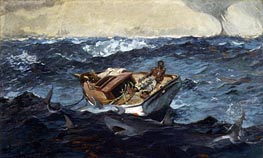
Giclée Canvas Print
$61.68
$61.68
SKU: 5569-HOM
Winslow Homer
Original Size:71.4 x 124.8 cm
Metropolitan Museum of Art, New York, USA
Winslow Homer
Original Size:71.4 x 124.8 cm
Metropolitan Museum of Art, New York, USA
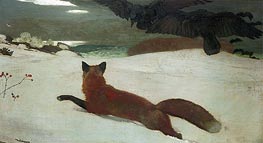
Giclée Canvas Print
$61.68
$61.68
SKU: 15744-HOM
Winslow Homer
Original Size:96.5 x 172.7 cm
Pennsylvania Academy of the Fine Arts, Philadelphia, USA
Winslow Homer
Original Size:96.5 x 172.7 cm
Pennsylvania Academy of the Fine Arts, Philadelphia, USA
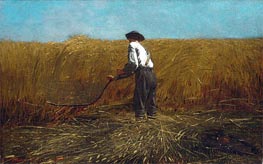
Giclée Canvas Print
$61.68
$61.68
SKU: 5562-HOM
Winslow Homer
Original Size:61.3 x 96.8 cm
Metropolitan Museum of Art, New York, USA
Winslow Homer
Original Size:61.3 x 96.8 cm
Metropolitan Museum of Art, New York, USA
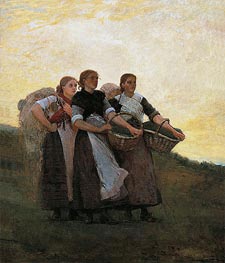
Giclée Canvas Print
$79.39
$79.39
SKU: 15807-HOM
Winslow Homer
Original Size:92.4 x 79.7 cm
Milwaukee Art Museum, Wisconsin, USA
Winslow Homer
Original Size:92.4 x 79.7 cm
Milwaukee Art Museum, Wisconsin, USA
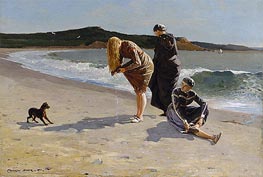
Giclée Canvas Print
$62.89
$62.89
SKU: 15735-HOM
Winslow Homer
Original Size:66 x 96.5 cm
Metropolitan Museum of Art, New York, USA
Winslow Homer
Original Size:66 x 96.5 cm
Metropolitan Museum of Art, New York, USA
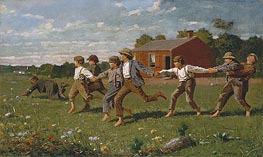
Giclée Canvas Print
$61.68
$61.68
SKU: 15739-HOM
Winslow Homer
Original Size:30.5 x 50.8 cm
Metropolitan Museum of Art, New York, USA
Winslow Homer
Original Size:30.5 x 50.8 cm
Metropolitan Museum of Art, New York, USA
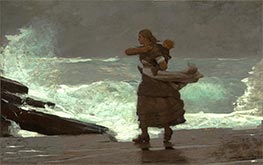
Giclée Canvas Print
$61.68
$61.68
SKU: 15805-HOM
Winslow Homer
Original Size:76.8 x 122.7 cm
Worcester Art Museum, Massachusetts, USA
Winslow Homer
Original Size:76.8 x 122.7 cm
Worcester Art Museum, Massachusetts, USA

Giclée Paper Art Print
$58.42
$58.42
SKU: 17832-HOM
Winslow Homer
Original Size:35.4 x 53.2 cm
Metropolitan Museum of Art, New York, USA
Winslow Homer
Original Size:35.4 x 53.2 cm
Metropolitan Museum of Art, New York, USA
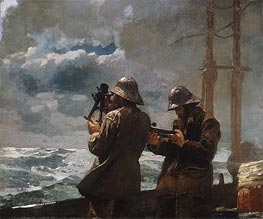
Giclée Canvas Print
$78.53
$78.53
SKU: 15743-HOM
Winslow Homer
Original Size:64 x 76.6 cm
Addison Gallery of American Art, Andover, USA
Winslow Homer
Original Size:64 x 76.6 cm
Addison Gallery of American Art, Andover, USA
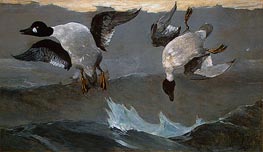
Giclée Canvas Print
$61.68
$61.68
SKU: 15800-HOM
Winslow Homer
Original Size:71.8 x 123 cm
National Gallery of Art, Washington, USA
Winslow Homer
Original Size:71.8 x 123 cm
National Gallery of Art, Washington, USA
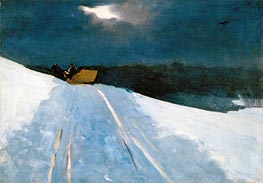
Giclée Canvas Print
$61.68
$61.68
SKU: 15777-HOM
Winslow Homer
Original Size:35.7 x 51 cm
The Clark Art Institute, Massachusetts, USA
Winslow Homer
Original Size:35.7 x 51 cm
The Clark Art Institute, Massachusetts, USA
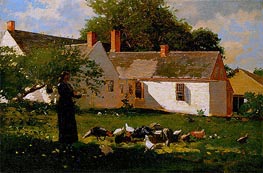
Giclée Canvas Print
$61.68
$61.68
SKU: 15778-HOM
Winslow Homer
Original Size:31.4 x 46.8 cm
The Clark Art Institute, Massachusetts, USA
Winslow Homer
Original Size:31.4 x 46.8 cm
The Clark Art Institute, Massachusetts, USA
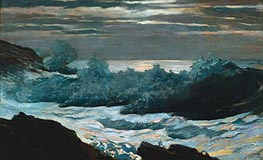
Giclée Canvas Print
$61.68
$61.68
SKU: 5568-HOM
Winslow Homer
Original Size:76.8 x 127 cm
Cleveland Museum of Art, Ohio, USA
Winslow Homer
Original Size:76.8 x 127 cm
Cleveland Museum of Art, Ohio, USA

Giclée Canvas Print
$61.68
$61.68
SKU: 15771-HOM
Winslow Homer
Original Size:61 x 26.6 cm
Phillips Collection, Washington, USA
Winslow Homer
Original Size:61 x 26.6 cm
Phillips Collection, Washington, USA
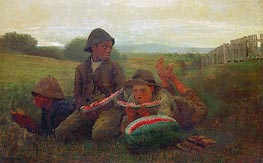
Giclée Canvas Print
$61.68
$61.68
SKU: 15795-HOM
Winslow Homer
Original Size:61.3 x 96.8 cm
Public Collection
Winslow Homer
Original Size:61.3 x 96.8 cm
Public Collection
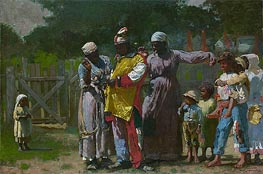
Giclée Canvas Print
$61.71
$61.71
SKU: 15732-HOM
Winslow Homer
Original Size:50.8 x 76.2 cm
Metropolitan Museum of Art, New York, USA
Winslow Homer
Original Size:50.8 x 76.2 cm
Metropolitan Museum of Art, New York, USA
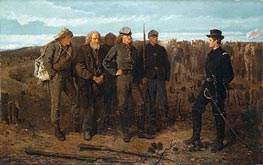
Giclée Canvas Print
$61.68
$61.68
SKU: 5578-HOM
Winslow Homer
Original Size:61 x 96.5 cm
Metropolitan Museum of Art, New York, USA
Winslow Homer
Original Size:61 x 96.5 cm
Metropolitan Museum of Art, New York, USA